Ninja Gaiden: Ragebound is a retro action platformer that tells the story of two rival ninjas swept up in a fight against an invading demon army. Kenji of the Dragon Ninja Clan and Kumori of the Black Spider Clan, members of ninja sects at odds in both philosophy and goals, each set out on their own quests to stop the invasion. Both fail and find themselves sharing a miserable death imprisoned in the demon’s realm. In a last, desperate act, the pair use a Black Spider weapon to bind Kumori’s soul to Kenji’s body, combining their spiritual power to give them the strength to escape. Now the former rivals must work together, assaulting their demon enemies with Kenji’s physical blade and Kumori’s spirit-powered arsenal to save both of their ninja clans and the world from annihilation.
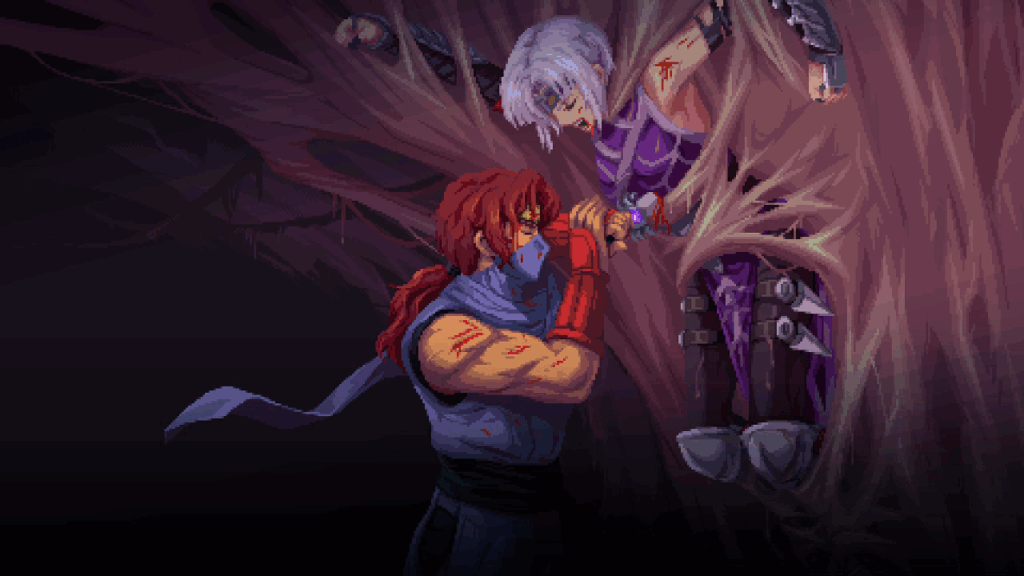
Ragebound’s story is too ridiculous to be accepted as anything but deliberately silly and bombastic, as exemplified by a character summarizing their situation with the line, “the CIA is toying with demon energy to create super soldiers.” The real attraction is the tight hack-and-slash combat based on prototypical ninja skillsets and platforming design inspired by the classic Ninja Gaiden titles from the 8-bit videogame generation. Fans of the first Ninja Gaiden videogames may also be enticed by a cameo from Ryu Hayabusa, the series’ original protagonist, and hints that his adventures in the United States are happening concurrently with Kenji and Kumori’s quest.
The feature that will most draw action platforming fans to Ragebound is the dual nature of its player character. Brief introductory levels steep me in each protagonist’s unique abilities before their souls are combined. Kenji is the familiar ninja platforming protagonist, outfitted with a sword and the ability to cling to walls, giving him the agility to spar face-to-face with any enemy he comes across. Kumori comes from a corporatized sect less concerned with honorable combat, happily dispatching her foes from a safe distance with innumerable thrown kunai and other sharp projectiles. Once they join together, Kenji appears to be the pair’s dominant force, but Kumori can appear at any time as a purple wraith that hurls her blades with deadly speed and accuracy.
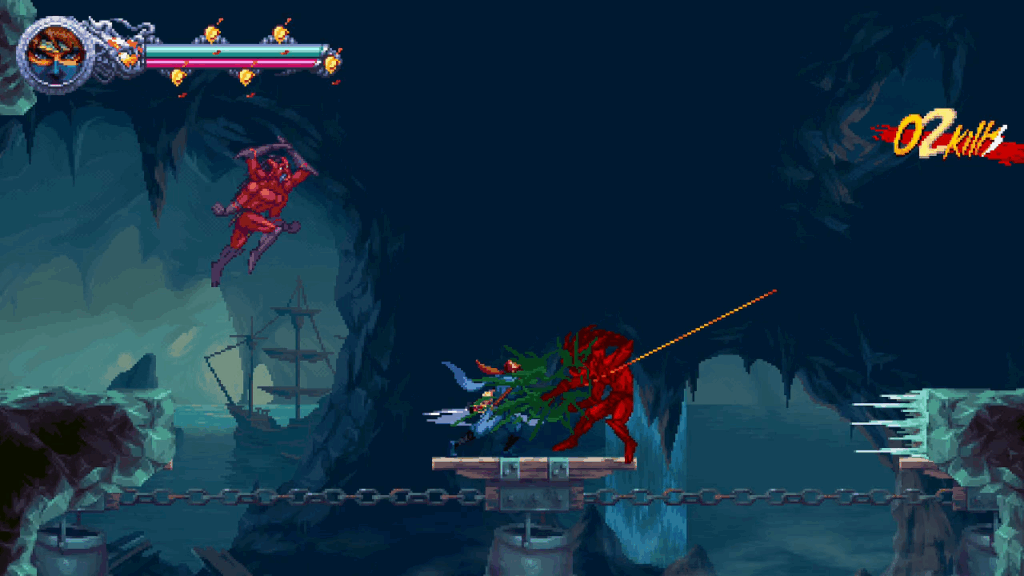
Most of the demons Kenji and Kumori fight may be dispatched with a single blow from either of their weapons. There are exceptions. Slothful and brutal demons equipped with heavy shields, massive blades, and unwieldy guns punctuate many enemy waves and platforming sequences. It’s possible to wear down these powerful demons with multiple blows, but their thick defenses and tricky attacks make this a risky choice. Getting past them quickly and efficiently is the basis for one of Ragebound’s primary and most enjoyable mechanics: hypercharged attacks.
Many of the weak demons Kenji and Kumori fight are marked with flashing glyphs. Killing these marked demons fills the protagonists’ shared body with energy for several seconds, empowering their next attack to penetrate defenses and fell any non-boss foe with a single strike. Instead of killing powerful demons through risky attrition, Ragebound encourages exploiting hypercharged attacks to progress. Sometimes the protagonists will have to kill a marked demon then carry the powerup quickly across a short platforming sequence. Sometimes they will have to ignore a powerful demon and fight off a small wave of weak ones before a marked demon appears. On the rare occasions the player character loses the hypercharged effect before they can expel it, they may charge another one for the cost of a small amount of health.
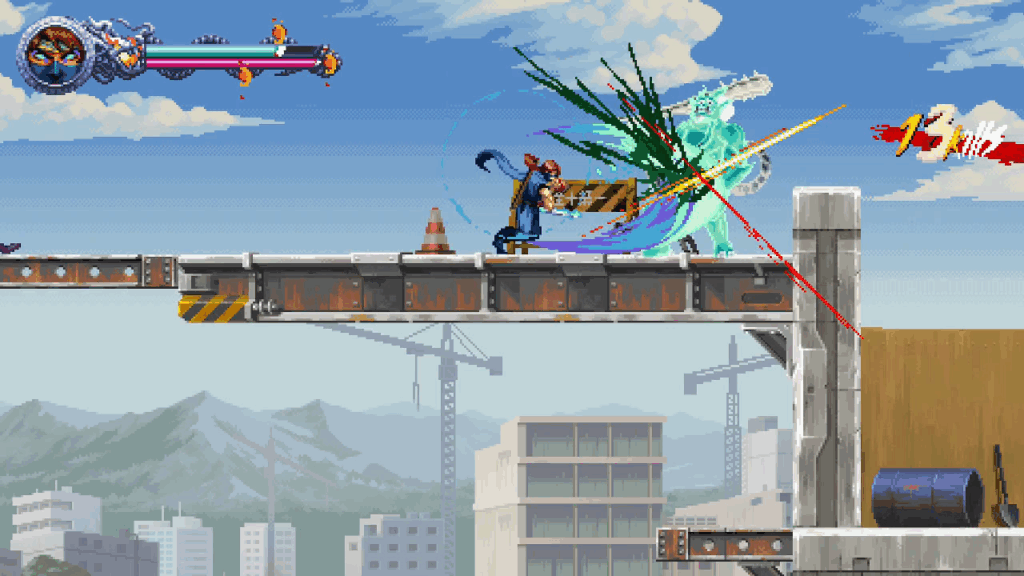
The real trick of glyphed enemies is they will only grant the hypercharged attack if they are defeated with the right attack. Demons marked with blue circles will bestow a hypercharge when killed by a swing from Kenji’s sword. Demons marked with pink diamonds bestow one when killed by one of Kumori’s projectiles.
This system turns any scenario with glyphed demons into an action-platforming puzzle. Most have a simple solution with a straightforward penalty for failure; if I direct the player characters to attack a purple-glyphed demon with Kenji’s sword, they are denied a hypercharged attack to take out a powerful demon as a penalty. Some demon combinations are more complicated. A room may be filled with many powerful demons, all of them glyphed, and some positioned so that they can only be reached with Kumori’s projectiles. I must quickly determine the order in which they need to be killed with which character’s weapons, execute that plan in the limited time allotted, and make no mistakes, all while continuing to move the player character away from an onslaught of demon attacks. If the demons are not defeated in the proper order, then I am penalized with a longer and more difficult fight. Exploiting glyphed demons becomes a lot to keep track of and feels immensely satisfying when done correctly.
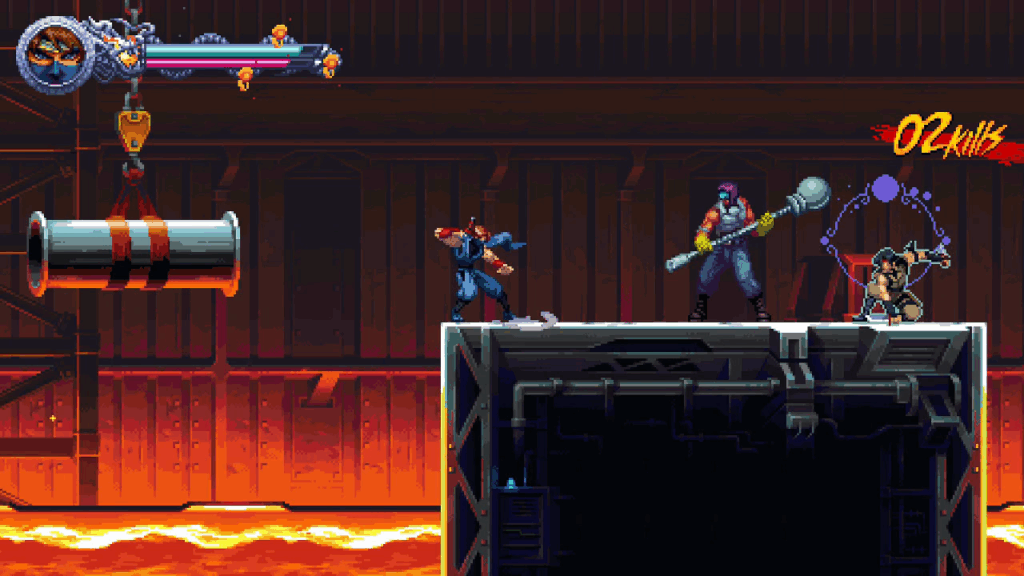
All of these systems carry forward into Ragebound’s boss battles. The sheer power of these hellish creatures is communicated through their toughness, each taking scratch damage from Kenji or Kumori’s weapons, able to absorb dozens of blows before succumbing. Bosses are designed around this quirk, emphasizing cooldown moments where the player characters may get in many quick and efficient blows with their weapons. For the rare boss who does not hold still for these long strings, waves of weak enemies periodically appear that always include at least one glyphed demon. Saving this power attack for the boss will stun them for several seconds, exposing them to a long string of sustained damage.
Despite these shared qualities, each boss is carefully designed with distinct features that ensure they all feel interesting and unique to fight. A dragon’s head emerging from the water to snap and breathe fire at the protagonists elicits an eyeroll when a second head predictably attacks a few moments later, but the way both heads work together to entrap their prey and the acrobatics required to avoid them is impressive. Other big nasties have more clear demonic aspects, infusing a hellbound nature to earthly forms. A massive demon with the arms and legs of a gorilla uses its fists to crush the ground, but the rocks these attacks kick up are an additional obstacle that harden into damaging spines when they impact the ground. This demon ensures no space on the battlefield is a safe place to stand. Multiple demon bosses are grotesque perversions of a woman’s body, intermingling their feminine features with insectoid wings they use to swoop across the battlefield or a protruding womb that spits out a steady line of tiny demon minions.
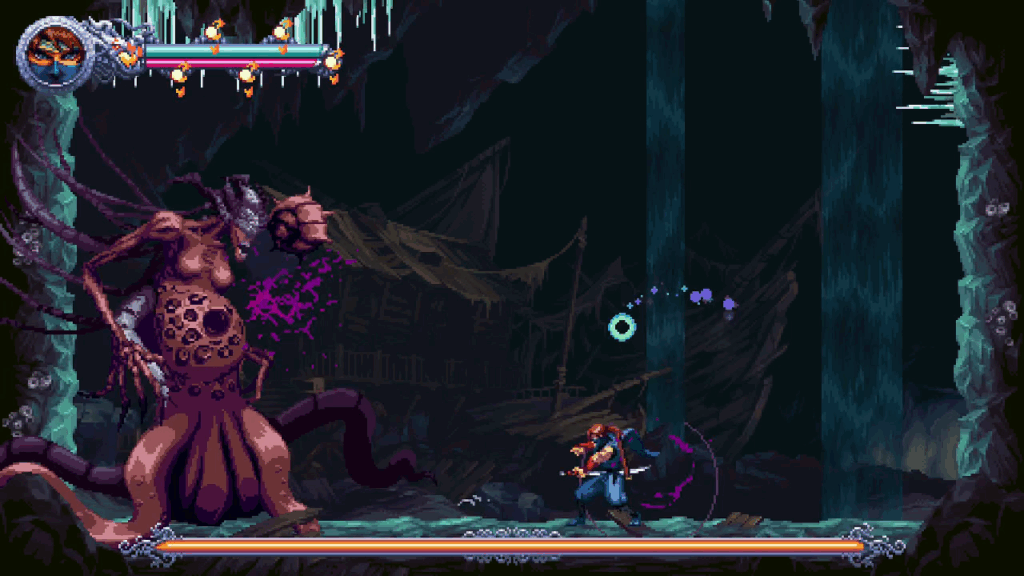
Ragebound’s platforming is equally as tight as its combat and draws heavily from Ninja Gaiden’s classic 8-bit sidescrolling installments. The first levels contrast the humble Dragon Ninja Clan village, guided by sage elders and supportive mentors, with the opulent skyscraper headquarters of the Black Spider Clan lorded over by a scheming council that intermingles a corporate boardroom with an organized crime ring. Subsequent plot twists and macguffins send Kenji and Kumori to environments all across Japan, from the ruins of a castle to a secret CIA laboratory to a pirate graveyard in a submerged cave to a 1980s action videogame classic, an entire level staged on the back of a speeding train. Ragebound does an incredible job balancing contemporary design philosophies with old-fashioned themes and tropes, truly embodying the word “retro.”
Kenji’s body is the vehicle both player characters occupy, and as he is a Dragon Ninja Clan member personally trained by Ryu Hayabusa, he handles in much the same way. His main platforming advantage is the ability to cling to and climb walls, letting him clamber up vertical surfaces like Spider-Man—ironic, given the antagonism apparent between the Dragon Ninja Clan and the Black Spider Clan as seen through Kenji’s and Kumori’s bickering.
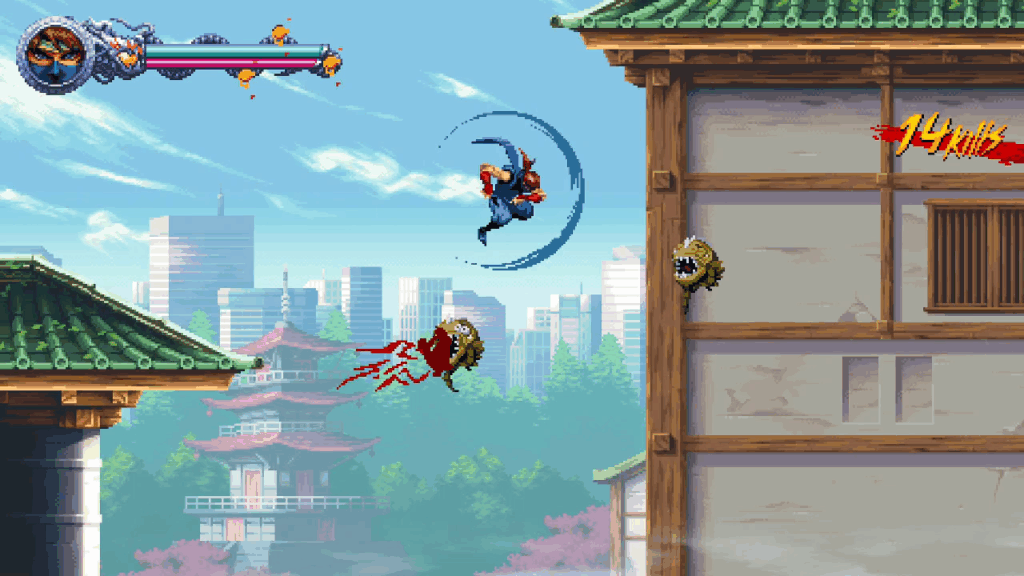
In addition to clinging to walls, Kenji can jump up to ceilings or climb down to the bottom of platforms to climb along those surfaces. He has also mastered a technique dubbed the Guillotine Boost, a spinning midair attack that sends him higher into the air when it impacts an enemy or obstacle. The Guillotine Boost may be used many times in a row to chain attacks between enemies or bounce off their heads through long segments of a level.
Most levels exploit all of the player characters’ abilities to add new dimensions to the platforming. A typical scenario requires them to leap from a wall, slide down a rope, bounce off a demon with a Guillotine Boost, then cling to the ceiling to bypass a long series of spike traps and bottomless pits laid out beneath them. These short, lightning-quick platforming sequences nearly always deposit the player characters directly into another battle.
As demanding as all of this ninja action and platforming is to my abilities, it is also forgiving. Kenji and Kumori share a lengthy hit point meter that is topped up often by regular checkpoints and passive healing effects, so even if they miss a jump, stumble into an enemy, or renew their hypercharged attack, there’s a lot of wiggle room to make those mistakes. Ragebound is challenging, but not grueling or even unfair in its platforming demands.
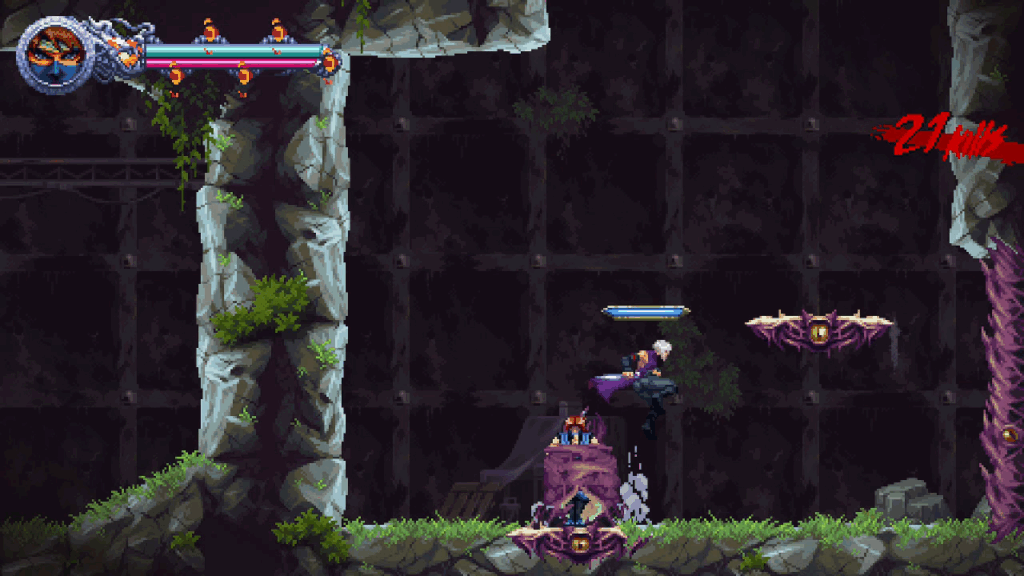
The exceptions are the Demon Altars. At multiple points in most levels, the player characters will reach a barrier they are unable to bypass. Conveniently, these barriers are always accompanied by a Demon Altar, a conduit into another layer of Ragebound’s world controlled by the demons. When Kenji activates a Demon Altar, Kumori’s spirit briefly disentangles itself from Kenji’s body and enters the parallel realm.
The demon layer is filled with teleporting devices that move Kumori across the screen when she strikes them with a thrown weapon, allowing her to access parts of the level beyond Kenji’s climbing skills. Kumori must not only navigate these elaborate platforming challenges, requiring precision jumps and perfectly aimed kunai, but also complete them in a tight time limit. Her ability to sustain her form in the demon layer is limited and a single mistake is often enough to force her to start over. Thankfully, there is no penalty for failure. Kenji must simply activate the Demon Altar once more to let Kumori try again.
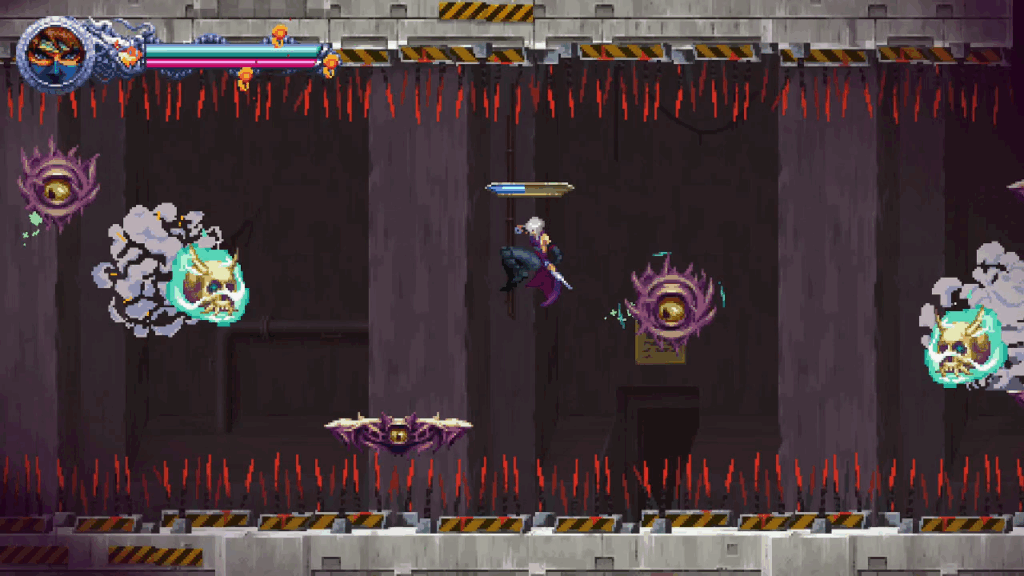
The most difficult Demon Altars the protagonists encounter are optional. Completing them rewards the pair with collectables, which can also be found hidden behind breakable walls or placed just out of reach of a regular jump. Collecting these colorful scrolls, scarabs, and skulls are how I access Ragebound’s remaining content. Scrolls open remixed versions of each level; they are shorter, but they are also much harder, including the most difficult Demon Altar challenges for Kumori to overcome. Scarabs may be taken to a shop run by a prototypically kooky and dangerous old man who sells Kenji and Kumori new weapons and abilities, including powerful team-up attacks that can give them the edge in the most difficult battles. Skulls are the most elusive collectables. They only unlock new costumes. They do not excite me.
There are more reasons to replay levels than just the collectables. Each has three challenges to complete. If a level seems difficult already, challenges take it to a new level with goals like beating bosses in tight time limits and crossing precarious platforming sections without taking damage. Each level also has a par time, demanding knowledge of the level’s layout and practice of every jump and sword swing to clear. There is also an unlockable hard mode. If these sound like too much, Ragebound also supports an accessibility mode with features that optionally slow down the game speed, decrease damage the player character takes, and other alleviating effects. All of these additions do a great deal to add to an enjoyable six hour playtime.
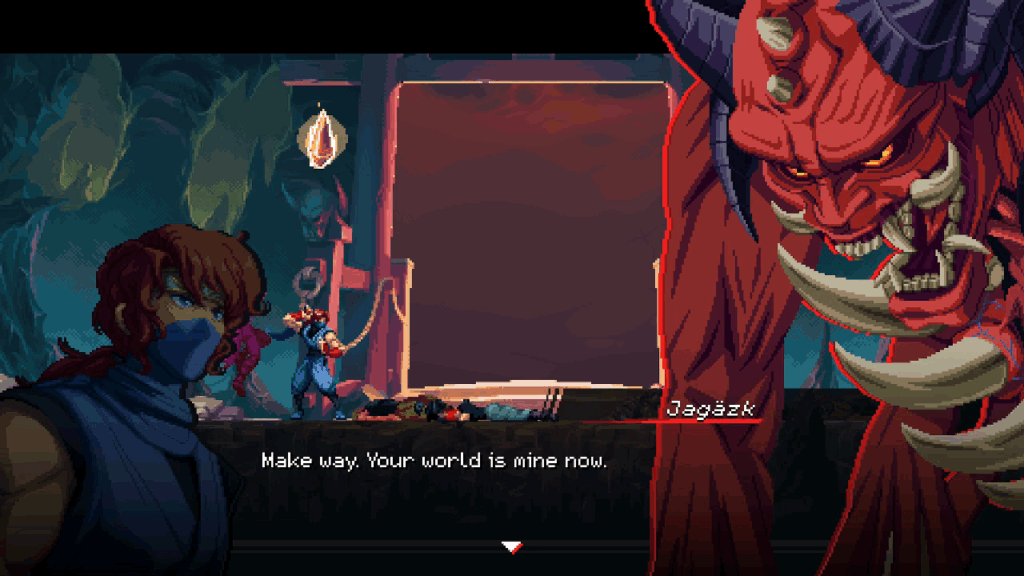
Ninja Gaiden: Ragebound embodies everything a retro platformer should aspire to be—unsurprising, since its developers have already proven their acumen with two installments of the Blasphemous nonlinear platforming series. Its concept of two protagonists inhabiting a single player character, unleashing their powers individually and intermingled in unexpected ways, is interesting without feeling too complicated. Its bosses are challenging, feeling superhumanly tough and yet not discouragingly unfair. It successfully recreates the best elements of classic Ninja Gaiden platforming with newer ideas that expand the Dragon Ninja moveset without feeling out of place. It’s long enough to be satisfying, not so long that it becomes tedious, and with plenty of optional collectables, goals, and unlockable difficulty levels to keep me replaying. It’s a fantastic use of my time and wonderful resurrection of a classic action-platforming franchise.